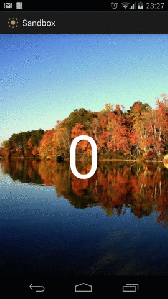ParallaxViewPager: parallax background effect for the ViewPager
The so-called parallax effect is common in both web design and in mobile apps, it can be found on the major platforms, from Windows Phone to iOS through Android. According to Wikipedia, Parallax scrolling is a special scrolling technique in computer graphics, wherein background images move by the camera slower than foreground images, creating an illusion of depth (…). A popular, but not over-used effect, which goes well with a ViewPager and can do wonders with the user experience. The Android SDK doesn’t provide a built-in way to achieve the effect, so I created my own interpretation.
There are already a few solutions to the problem online, but none of them was a perfect match for my needs. GitHub user ChrisJenx’s Paralloid library is a good one, but it doesn’t work with the ViewPager. Most solutions available are based on a custom PagerTransformer, but I tried a different approach by extending the ViewPager and implementing a custom onDraw logic. I wrapped the whole thing into a custom view called ParallaxViewPager, which is available at GitHub and to be used as a Gradle dependency.

Using the ParallaxViewPager
Setup requires little extra effort, using the ParallaxViewPager is just like using a standard ViewPager, with the same adapter. Of course, there’s no silver bullet – the developer has to supply a background tailored to the current needs (eg. the number of items in the adapter and the size of the ViewPager).
First, include it in your project as a Gradle dependency:
dependencies {
compile 'com.andraskindler.parallaxviewpager:parallaxviewpager:0.2.0'
}
After creating a ParallaxViewPager either programmatically or in a layout xml, set the background with one of the following methods, or via xml:
- setBackgroundResource(int resid)
- setBackground(Drawable background) or setBackgroundDrawable(Drawable background)
- setBackground(Bitmap bitmap)
And that’s all, the ParallaxViewPager is fully functional. You can tweak the experience by modifying the scrolling effect of the background. You can specify how the view should scale the image with the setScaleType(final int scaleType) method. This only works with FIT_HEIGHT. Choose from the following parameters:
- FIT_HEIGHT
- FIT_WIDTH
means the height of the image is resized to matched the height of the View, also stretching the width to keep the aspect ratio. The non-visible part of the bitmap is divided into equal parts, each of them sliding in at the proper position. This is the default value.
means the width of the background image is divided into equal chunks, each taking up the whole width of the screen. This mode is not the usual parallax-effect, as the speed of the background scrolling equals the speed of the views.
Yo can also set the amount of overlapping with the setOverlapPercentage(final float percentage) method. This is a number between 0 and 1, the smaller it is, the slower is the background scrolling. The default value is 50 percent.
Examples
Creating the ParallaxViewPager instance inside the onCreate() of an activity:
//...
final ParallaxViewPager parallaxViewPager = new ParallaxViewPager(this);
parallaxViewPager.setAdapter(new MyPagerAdapter());
parallaxViewPager.setBackgroundResource(R.drawable.background);
setContentView(parallaxViewPager);
//...
Creating the ParallaxViewPager in a layout xml, then modifying the overlapping percentage and assigning an Adapter:
activity_main.xml
<com.andraskindler.parallaxviewpager.ParallaxViewPager
xmlns:android="http://schemas.android.com/apk/res/android"
android:id="@+id/parallaxviewpager"
android:layout_width="match_parent"
android:background="@drawable/background"
android:layout_height="match_parent"/>
MainActivity.java
//....
setContentView(R.layout.activity_main);
final ParallaxViewPager parallaxViewPager = ((ParallaxViewPager) findViewById(R.id.parallaxviewpager));
parallaxViewPager
.setOverlapPercentage(0.25f)
.setAdapter(new PagerAdapter()
//...
Wrap-up
The class is far from complete, there is room for a lot of improvement, so don’t hold back, ideas, feedback and pull requests are welcome! You can find the project on GitHub.
Pingback: ViewPager的视差背景效果 | EnlangTech
Any reason to not support API 10?
Not really…our lowest supported API level currently is 14, this is why I went with ICS. If you need to support lower API levels, feel free to fork the project (it might actually work without modification), pull requests are welcome!
Pingback: .NET i jiné ... : Odkazy z prohlížeče – 9.6.2014